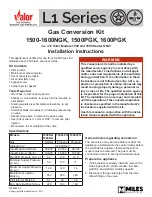
FLAMMABLE GAS SENSOR/TRANSMITTER
A T E X
M1
GROUP I & II
INTRINSICALLY
SAFE
5 INSTALLATION
continued
5.2 Location
Ea ch install atio n needs to be consid ered in i ts own right, wit h r efe rence to
safety au thorities and in c omplia nce wit h mandatory local safety r egula tio ns.
The sensor m ust be operated in accordance wit h the Installatio n and
Operating Da ta to main tain safe ty, r elia bility and to preserv e Intrinsic Safet y
in tegrity w here applicable.
It is important that sensors are located in positions determined in consultation
with those who have specialised knowledge of the plant or installation and of the
principles of gas dispersion. Reference should also be made to those responsible for
the engineering layout and topology of the plant as they will be most familiar
with the nature of the potential dangers and the most likely sources of gas release.
It is also important to recognise that the characteristics of the gas source can be
influenced by many factors; including the relative density or buoyancy of the gas,
the pressure at the point of release, the ambient temperature and the ventilation
of the site.
Sensor coverage cannot be simply expressed in terms of ‘number per unit area’.
Sensors need to be sited where they are capable of monitoring those parts of a
plant where gas may accumulate or when a source of gas release is expected
to occur. This way the earliest possible warning of a gas release can be given to
initiate shutdown functions, alarm functions or safe evacuation of the premises.
5.3 System Integrity
If a gas monitoring system should fail for any reason, it is important that the system is
capable of immediately alerting operational staff to this fact.
The sensor will indicate a system failure or mechanical defect and this information can
be utilised to initiate a warning alarm. It is good practice to provide emergency
facilities to protect against the loss of the mains power supply.
Standby batteries can be incorporated with automatic changeover facilities, so
guaranteeing continued operation of the gas sensing system even in the event of
a plant breakdown as a result of a power supply failure.
Certainly, in critical plants, duplication or triplication of sensors is recommended.
The Trolex TX9042 or TX9044
Programmable Sensor Controller
can be programmed to operate
with sensors in the multiple
voting mode.
5.4 Sensor Management
A very important part of an efficient gas monitoring system is the training of
plant personnel in operation and maintenance of the sensors and the complete
monitoring system. Training facilities can be provided by qualified Trolex
application engineers.
Once a sensor installation is complete, the sensor locations and types should be
formally recorded and a planned test and maintenance procedure instituted.
7/28
INSTALLATION & OPERATING DATA
TT X
X 66 33 88 33
ISSUE S 01/15








































